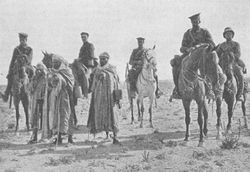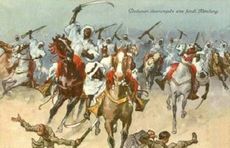معركة وادي الصنب
| معركة وادي الصنب | |||||||
|---|---|---|---|---|---|---|---|
| جزء من حملة السنوسية | |||||||
 منطقة عمليات الحملة السنوسية. | |||||||
| |||||||
| المتحاربون | |||||||
|
|
| ||||||
| القادة والزعماء | |||||||
|
السيد أحمد الشريف، جعفر پاشا |
و. إ. پايتون أ. والاس هنري لوكين هـ. و. هودجتون | ||||||
معركة وادي الصنب، هي جزء من حملة السنوسية، وقعت بين مطروح ورأس رخم على الحدود المصرية الليبية، من نوفمبر 1915 حتى فبراير 1917 أثناء الحرب العالمية الأولى. كانت الحملة بين الامبراطورية البريطانية، إيطاليا، والسنوسيين، طائفة دينية تضم رجال القبائل في ليبيا، بدعم من الدولة العثمانية والامبراطورية الألمانية. (قوات الامبراطورية البريطانية في تلك المعركة كانت تشمل قوات من بريطانيا، جنوب أفريقيا، أستراليا ونيوزيلاندا، واللواء 15 السيخي.)[1] أقنعت الدولة العثمانية زعيم السنوسيين، السنوسي الكبير أحمد الشريف السنوسي، في صيف 1915، بأن يأمر رجاله بالهجوم على مصر الواقعة تحت الاحتلال البريطاني من الغرب، إعلان الجهاد، وتشجيع التمردات ضد البريطانين في مصر. أقنعت الدولة العثمانية السيد أحمد بالهجوم، لأنها كانت تعتقد أن ذلك سيزيد من فرصة العثمانيين في الإستيلاء على قناة السويس من الشرق. عبر السنوسيين الحدود الليبية المصرية في نوفمبر 1915.
خطط السنوسيون لثلاث حملات في مناطق مختلفة ضد البريطانيين. الحملة الأولى وقعت على إمتداد الساحل المصري. في هذه الحملة، والتي بدأت في نوفمبر 1915، انسحبت القوات البريطانية في البداية لكنها بعد ذلك هزمت السنوسيين في اشتباكات مختلفة، منها معركة أجاجيا، وإستردوها، بمساعدة تعزيزات جنوب أفريقية، وفقدت جميع الأراضي المصرية على الساحل بحلول مارس 1916. كانت حملة 'عصابة الواحات' آخر مواجهة تم صدها.
مقدمة
قبل 1906، عندما اشترك السنوسيون في مقاومة الفرنسيين، كانوا قد أصبحوا "الطائفة الدينية السلمية نسبياً في الصحراء الغربية، المعارضة للتعصب". عندما غزا الإيطاليون ليبيا عام 1911، واحتلوا الساحل، قاومهم السنوسيين من المناطق الداخلية للبلاد. أثناء مقاومتهم للإيطاليين، حافظ السنوسيين على علاقات صداقة مع البريطانين في مصر. أعلنت المملكة المتحدة الحرب على الدولة العثمانية في 5 نوفمبر وشجع قادة الدولة العثمانية السنوسيين على الهجوم على مصر من الغرب. أراد العثمانيون من السنوسيين القيام بعمليات على الدفاعات الخلفية لقناة السويس. فشل العثمانيون في هجماتهم السابقة على القوات البريطانية من سيناء إلى الشرق وأرادوا مهاجمة هذه القوات من الاتجاه المعاكس. بحلول نوفمبر 1915، كانت قوة التواجد البريطاني في مصر قد انخفضت، لأن الجنود تم نقلهم من مصر لاستخدامهم في گاليپولي وبلاد الرافدين. الحدود الغربية لمصر كانت تحت حماية حرس السواحل المصري.
في صيف 1915، القوافل الأمنية التركية، وتشمل نوري باي، الأخ غير الشقيق لأنور پاشا وجعفر پاشا، عربي بغدادي في صفوف الجيش العثماني، والذي سيصبح فيما بعد قائد القوات السنوسية المقاتلة في الحملة الساحلية، ناقش اتفاقية مع السنوسي الكبير السيد أحمد الشريف، زعيم السنوسيين، للهجوم على البريطانيين في مصر من الغرب. لم يكن قراره مؤيداً من كل السنوسيين. وفر العثمانيون المدافع الآلية، المدافع، باستخدام سفن وفيما بعد غواصات ألمانية لتوصيل الأسلحة والأموال للسنوسيين.[2]
المعركة
في 20 نوفمبر 1915، شكل البريطانيون قوة الحدود الغربية. كان قائدها الميجور جنرال أ. والاس وحشد قواته عند مطروح. عبر سكك حديدية خفيفة نقل قواته من الإسكندرية إلى الضبعة، ومن هناك انتقل عن طريق السفن على بعد 75 ميل من مطروح.[3]
كانت قوة الحدود الغربية تضم لواء مشاة يضم ثلاث كتائب بريطانية مدربة جزئياً، the 6th Royal Scots and the 2/7th and 2/8th Middlesex, plus the 15th Sikhs. The other main component of the WFF was the cavalry brigade consisting of three composite British Yeomanry regiments and a composite regiment of Australian Light Horse. Brigadier-General the Earl of Lucan commanded the infantry, and Brigadier-General J.D.T. Tyndale-Biscoe commanded the cavalry. The 15th Sikhs was the only regular major unit. The one artillery battery, the Notts Battery Royal Horse Artillery, was to perform very well in the forthcoming actions.
By the 3rd December the British garrison at Matruh numbered 1,400 men. New arrivals included ‘A’ Battery. Honourable Artillery Company, two 4-inch guns manned by Royal Marines, two aircraft of the 17th Squadron, Royal Flying Corps, and a six-car detachment from the Royal Naval Armoured Car Division. Meanwhile, over 2,000 of the Senussi’s men were believed to be moving south and west of Matruh.
On the 11th December, General Wallace sent out a column to disperse a group of enemy reported to be at Duwwar Hussein, sixteen miles west of Matruh. Lieutenant-Colonel J.L.R. Gordon, 15th Sikhs, was appointed Column Commander. The column consisted of the 15th Sikhs, less two companies, the 2nd Composite Yeomanry Regiment, a section of guns of the Notts Battery and a detachment of armoured cars. Lieutenant-Colonel Gordon took his infantry along a track that followed the telegraph line westwards to Sollum, while the cavalry, guns and armoured cars used a road to the south-west, known as the Khedivial Motor Road, which also led to Sollum.
The mounted column departed at 07.00 hrs on 11th December, but the cavalry moved so quickly that the scouts could not keep sufficiently ahead of the main body. Around 300 enemy were waiting to the north of the road in the Wadi (valley) Senab, and they successfully ambushed the cavalry. Attempts made to turn the enemy’s right flank were driven back by heavy fire, and a stalemate existed until a squadron of Australian Light Horse arrived from Matruh in the afternoon. Then, using artillery support, the cavalry forced the enemy group out of its position. Eighty dead and seven prisoners were left behind by the Senussi troops. British losses were sixteen killed and seventeen wounded. During this action Lieutenant-Colonel Gordon continued along his track and established a firm base at the Umm Er Rakham wells. The cavalry joined him here during the night.
As the cavalry mounts were now exhausted, the 12th December was spent in resting and in rounding up nearby enemy stock. The 6th Royal Scots, less two companies, joined Gordon during the night of the 12th, as did a convoy of stores. On the following morning at 08.30 hrs, Gordon marched west to Wadi Hasheifat planning to turn south up the wadi towards Duwwar Hussein. As the track was expected to be unfit for heavy wheels, the sixty 1st Line Transport pack mules of the 15th Sikhs were loaded with reserve ammunition and extra water for the column. One company of the 15th Sikhs was left to guard the camp.
As the British column approached the Wadi Hasheifat from the east, the cavalry was forward and dispersed, No. 2 Company of the 15th Sikhs was the advanced guard, and two platoons of the Royal Scots formed the left flank guard. Lieutenant-Colonel Gordon heard heavy firing on his left and observed his left flank guard running very swiftly towards the shore, pursued by an equal number of uniformed and well-drilled soldiers who used formations and cover as they followed up the fleeing Royal Scots. The British soldiers were making no attempt to engage the enemy, who were troops of the Muhafizia, the Senussi’s regular army trained by the Turks. The Sikhs’ two machine guns came into action to halt the enemy advance.
Many more of the enemy now appeared and Lieutenant-Colonel Gordon decided to fight on the edge of the plateau that rose from the coastal plain. The Royal Scots were ordered to move forward and to the left, and the cavalry were brought back to man the right of the line; however the cavalry took some time to reorganize, and the Royal Scots appeared unwilling to advance. This left the advanced guard, which had occupied some mounds, in an exposed position and Gordon ordered it to withdraw towards the headquarters. The 15th Sikhs’ company commander, Captain C.F.W. Hughes, replied that he could not comply with the order unless he abandoned his wounded, and that he was therefore obliged to hold his ground. The enemy increased the pressure around 10.00 hrs by bringing 4-inch guns into action and by effectively deploying machine guns.
Lieutenant-Colonel Gordon radioed back to the camp at Umm Rakham ordering forward all reinforcements that could be spared, and the machine gun section of the Royal Scots and seventy-five men of the Australian Service Corps, armed with rifles, were sent forward. As these reinforcements approached the main body, an enemy machine gun engaged them. This induced the Royal Scots machine gun section to break and run for cover with their guns into the sand dunes on the beach, but the Australians stayed and fought well. Finally two squadrons of Australian Light Horse came forward from Matruh and escorted two Royal Horse Artillery field guns onto the beach where they engaged the Senussi’s warriors. Also HMS Clematis, a newly-built submarine trawler mounting two 4-inch guns, appeared offshore and fired at the enemy positions. A lucky British shell exploded amongst one of the largest groups of enemy, scattering it, and that was the turning-point of the action. The enemy began to withdraw, and as his machine guns ceased firing the Royal Scots advanced to their nominated objective. The 15th Sikhs advanced guard regrouped and evacuated its four dead and nineteen wounded.
Knowing he could not achieve a decisive result and aware of the fatigue felt by men and mounts, Lieut.-Colonel Gordon withdrew his men to their camp and on the next day the column returned to Matruh. British casualties amounted to nine killed and fifty-six wounded whilst enemy casualties were around 100 killed and wounded. The Official History comments:
‘The enemy had been driven off, but had been able to retire unmolested, and must be given credit for the surprise and the vigour of his attack. Had the standard of training and the experience of the whole column been equal to those of the 15th Sikhs, the Senussi might have been heavily defeated.’
النتائج
The Senussi and his followers continued to present a security threat in the Western Desert for a further twelve months. But the participation of the 15th Sikhs in the campaign was over, as the regiment now received orders to proceed to India. The 15th Sikhs had borne the brunt of the fighting so far, and had provided the backbone for a very untrained, inexperienced and under-staffed Western Frontier Force. The regiment had acquitted itself with distinction, and for its services in this theatre it received the honour ‘Egypt 1915-17.’ As a result of the post-war reforms of the Indian Army, it became the 2nd Battalion, 11th Sikh Regiment. ___________
انظر أيضاً
المصادر
- ^ Richard, J (9 September 2007), Senussi Uprising, 1915–1917, Military History Encyclopedia on the Web, http://www.historyofwar.org/articles/wars_senussi_uprising.html
- ^ Evans-Pritchard 1954, p. 121
- ^ The Egyptian Western Desert, November 1915 to February 1916, kaiserscross.com
المراجع
- Russell McGuirk, The Sanusi’s Little War
- The 15th Sikhs War Diary (copy kindly provided by Russell McGuirk)
- Lieut.-General Sir George Macmunn & Captain Cyril Falls, Official History of the War, Military Operations Egypt and Palestine, from the outbreak of war with Germany to June 1917
- Field Marshall Lord Carver, The National Army Museum Book of the Turkish Front 1914-18
- Peter Duckers, Reward of Valor, The Indian Order of Merit 1914-1918
- Rana Chhina, The Indian Distinguished Service Medal


